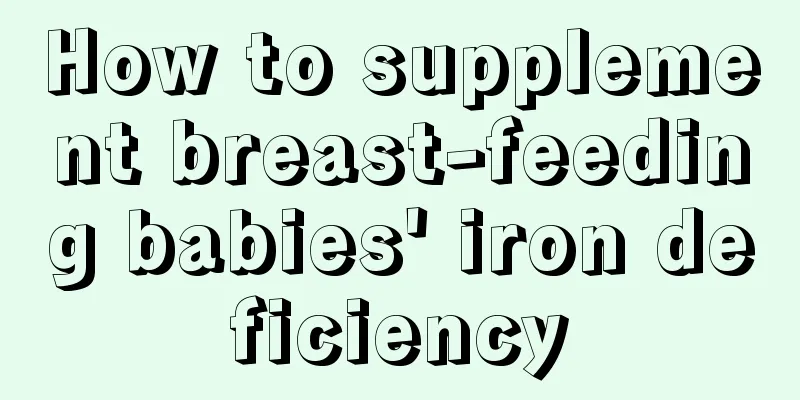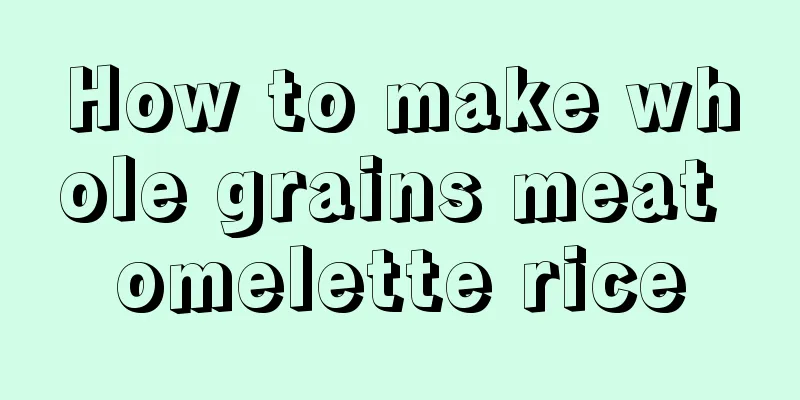How to supplement breast-feeding babies' iron deficiency

|
Iron is an essential trace element in the human body, but some babies often suffer from iron deficiency. However, since iron deficiency does not have very obvious symptoms, many parents are unaware that their babies have iron deficiency. Especially for babies who are still breastfeeding, iron deficiency is most likely to occur. So how should breastfeeding babies make up for iron deficiency? Why do breastfed babies suffer from iron deficiency? Iron deficiency is one of the common nutritional problems in breastfed babies. Iron deficiency can lead to anemia. If the symptoms are mild, they are not easy to detect. Babies generally show symptoms such as listlessness, crying easily, clinging, fatigue, and rapid breathing. Babies with more severe iron deficiency will have pale complexion and skin, and their mental, behavioral, cognitive, and psychological development will be relatively delayed. Why are breastfed babies more likely to develop iron deficiency after 4 months? ● The body’s iron reserves are limited Under normal circumstances, the mother can provide the baby with abundant iron reserves in the late pregnancy. If the baby is born full-term, the baby can obtain enough iron from the mother to consume for 4 months. Therefore, babies under 4 months old rarely suffer from iron deficiency anemia. Premature, twin, or multiple-birth babies receive less iron from their mothers over a shorter period of time and in less total amount than full-term babies, and their iron storage at birth is also reduced. If the mother does not consume enough iron during pregnancy and is anemic, the baby is likely to suffer from iron deficiency anemia after birth. ● Inadequate iron intake Breast milk is rich in nutrients, easy to digest and absorb, and is the best food for babies. The iron content in breast milk is low. Although breast milk contains ferritin, which can increase the bioavailability of iron, babies over 4 months old cannot get enough iron from breast milk alone because they have a high demand for iron. ● Accelerate the baby's growth and development The baby's growth and development is very rapid. At 4-5 months, his weight is twice that of a newborn, and at 1 year old, it is 3 times his weight. His blood volume also increases rapidly. Iron is a necessary raw material for the formation of hemoglobin. If the baby's iron intake cannot reach a balance between supply and demand in time, iron deficiency is likely to occur, causing anemia. The weight and blood volume of premature babies increase faster, increasing six times by the age of one, so premature babies need much more iron than full-term babies. ● Excessive iron consumption or loss If the baby has milk allergy, chronic diarrhea, repeated infections, etc., it will lead to reduced iron absorption, increased consumption, and iron deficiency. Iron Supplements for Breastfeeding Mothers Step by Step Step 1: Eat more iron-rich foods The postpartum diet of breastfeeding mothers should be nutritious, with a combination of coarse and fine grains, meat and vegetables, and they should eat more iron-rich foods. Among animal foods, chicken liver, pork liver, pig blood, and animal offal are particularly rich in iron and have a high absorption rate. The second is lean meat, fish and other river and sea products. Among vegetable foods, kelp, seaweed, black fungus, black beans, red beans, sesame, red dates, spinach and other foods have higher iron content, but the absorption rate is not as high as the above-mentioned animal foods. Step 2: Two forms of iron in food Non-heme iron Non-heme iron is mainly found in plant foods. It will be interfered by other food components such as cellulose and oxalic acid, and its absorption rate is very low. Heme iron Heme iron is mainly found in animal foods, such as hemoglobin and myoglobin. It is not interfered by other dietary factors and has a higher absorption rate. Therefore, the absorption rate of iron in animal foods is much higher than that in plant foods. The absorption rate of iron in animal liver is 22%, hemoglobin is 25%, fish is 11%, flour and wheat are 5%, black beans and corn are 3%, fruits and vegetables are 3-4%, eggs are only 3%, and rice is 1%. Step 3: Vitamin C can promote iron absorption Breastfeeding mothers can eat iron-rich foods together with vegetables and fruits rich in vitamin C, which can greatly promote iron absorption. Foods rich in vitamin C include spinach, celery, tomatoes, pineapple, strawberries, kiwi, citrus, cherries, etc. Eating iron-containing foods together with foods rich in high-quality protein such as meat and eggs can also increase the absorption rate of iron and the complementary effect of protein. |
Recommend
How to cook scallion-flavored hairtail
Many of our friends often neglect eating and have...
How to make wheat bran baguette
Everyone pursues a life of having food and clothi...
Bacon and milk macaroni recipe
Many modern people spend their days in a hurry, h...
How to make fried yuba with pepper and black fungus
The Internet is so developed that you can learn t...
How to make pea seedlings and shrimp soup
I always envy other people’s tables full of delic...
Cinnamon bun recipe
Eating out may seem to save you trouble on the su...
How to make banana cake
Banana cake is a very common recipe that many peo...
How to make red oil chicken slices
Food requires nutritional balance. Not only will ...
No-Bake Pecan Cheesecake Recipe
Everyone knows that diet is particularly importan...
How to make oat noodle dumplings
Everyone pursues a life of having food and clothi...
Onion meat pie recipe
Do you always eat instant noodles whenever you ar...
How to make three fresh dumplings
As people's living conditions have improved, ...
How to make French homemade cakes
When you come back from a day's work, you mus...
How to make fresh duck gizzard soup with ginseng and Chinese yam
Everyone pursues a life of having food and clothi...
How to cook beer-roasted pig's trotters
Food is vital to our human body and is closely re...









